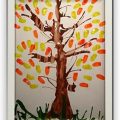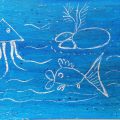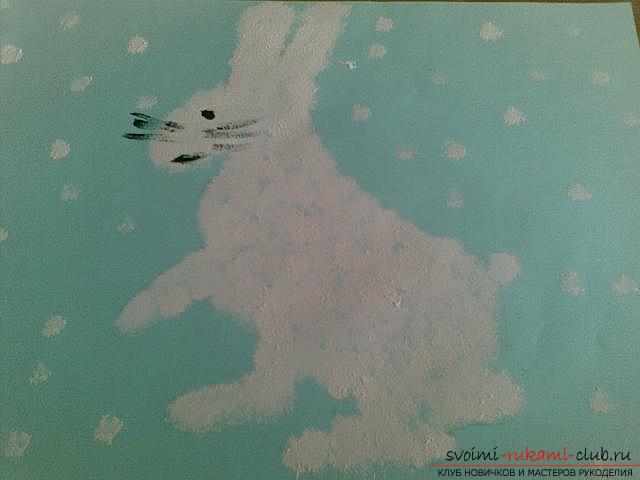
Teach children to draw in middle groups will help the use of non-traditional painting techniques
Using non-traditional drawing techniques inmiddle groups of the kindergarten enables educators to educate children in drawing, to show new ways of working on creating a drawing, and for children to reflect the world around them on paper, to make imaginary objects and wildlife objects into real forms and just get a lot of positive emotions. Moreover, such exercises are absolutely not complex and more like a game than a learning process. It's no secret that every child enthusiastically takes pencils, brushes and paints, felt-tip pens and tries to draw. Considering that every kid is a person, the abilities of all are different. Someone immediately intuitively draws the correct lines and shapes, but for others such a process is complex and almost impossible. At an early age (younger groups of the kindergarten), the children do not think much about whether they are doing everything right and drawing with ecstasy. Growing up, they are already beginning to compare their works of art with the creativity of their friends and if they notice that their drawings do not meet any requirements or worse than that of another child, then they simply abandon this occupation. And the task of adults is to not let the child get disappointed in themselves and their strengths. After all, there is not a single person in the world who could not not learn how to draw. The use of non-traditional painting techniques in the middle groups of the kindergarten is a unique method that promotes the development of the basics of visual creativity, the study of new techniques, the acquisition of new knowledge, the acquisition of necessary skills. In addition to all of the above, non-traditional techniques allow:
- develop the child's intellectual abilities;
- to correct mental processes and personal sphere of the child;
- increase the level of self-esteem of the child, instill in him self-confidence and his own strength;
- develop spatial thinking;
- develop fine motor skills;
- to teach the children to express their vision, their plan.
The choice of techniques for drawing depends on the agefeatures of children. So, for example, children of the younger group (2 - 3 years) are taught to draw with their fingers, palms, the edge of the palm. Impressions of seals made from such simple and accessible material as, for example, potatoes, prints of leaves of trees, poking hard dry brush. In the middle group of the kindergarten, all the same techniques are applied, only the drawings created in this way are of great complexity and, also, more complex methods are added, in particular:
- foam rubber printing;
- drawing wax crayons + watercolor;
- drawing with a candle + watercolor;
- drawing with cotton buds;
- nitcography.
As already mentioned, each of the aboveways, above all, is a game and only then a learning process. That's why children are interested in doing this kind of work. They get real pleasure, behave naturally, draw with pleasure, without fear of spoiling anything or doing something wrong, because you can always correct such a pattern by adding new strokes. Children have the opportunity to express themselves and they use it successfully. Consider in more detail the drawing techniques that are relevant for this age category. Drawing a palm For this technique you will need gouache paints and wide containers for them and napkins to wipe the hands. At the end of the work, gouache from hands is easily washed off with ordinary water. In the younger group, the babies just dab the palms into the paint and then leave prints on the paper. In the middle group, the guys also use a brush. By means of a brush they put a paint on palms and fingers. In this case, each finger can be painted in its own color. First, an imprint is left on the paper, and then small details are added and interesting animals or birds are obtained, as in the photo. In the younger group, the teacher draws small details. In the middle - the child himself can make the necessary manipulations. 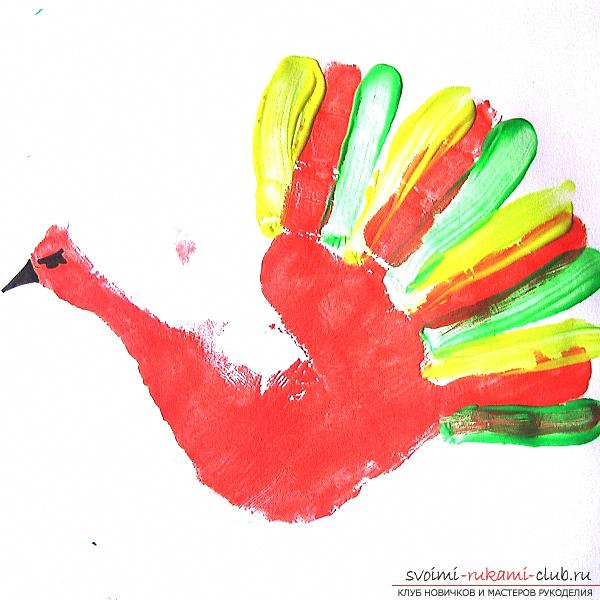 Drawing with fingers Fingers draw the same way,as well as a palm, but with some difference. If you leave prints. You can depict with their help this or that weather phenomenon, draw a flower or a pretty face and so on. If, in addition to prints, also draw lines, do strokes and so on, you can get a more complete picture or more realistic. At this age, even without the help of an adult, children can themselves reproduce an interesting image.
Drawing with fingers Fingers draw the same way,as well as a palm, but with some difference. If you leave prints. You can depict with their help this or that weather phenomenon, draw a flower or a pretty face and so on. If, in addition to prints, also draw lines, do strokes and so on, you can get a more complete picture or more realistic. At this age, even without the help of an adult, children can themselves reproduce an interesting image.  Drawing potatoes or other seals Peaches- a unique tool for drawing, with which the child can easily create an amazing picture, repeating the imprinting of one pattern in a certain sequence. In this way, you can simply make a background on paper, or you can draw an object. The gloves are made of stoppers and bottoms or plastic bottles. An interesting option and a signet from raw potatoes. In any case, an adult is needed. To make an instrument from potatoes, it is cut in half. A contour of an animal or other object is drawn on the cut, and then this shape is cut out. Stamp cushions with paint are also required. First, the seal is pressed against the pillow, and then to the paper sheet.
Drawing potatoes or other seals Peaches- a unique tool for drawing, with which the child can easily create an amazing picture, repeating the imprinting of one pattern in a certain sequence. In this way, you can simply make a background on paper, or you can draw an object. The gloves are made of stoppers and bottoms or plastic bottles. An interesting option and a signet from raw potatoes. In any case, an adult is needed. To make an instrument from potatoes, it is cut in half. A contour of an animal or other object is drawn on the cut, and then this shape is cut out. Stamp cushions with paint are also required. First, the seal is pressed against the pillow, and then to the paper sheet. 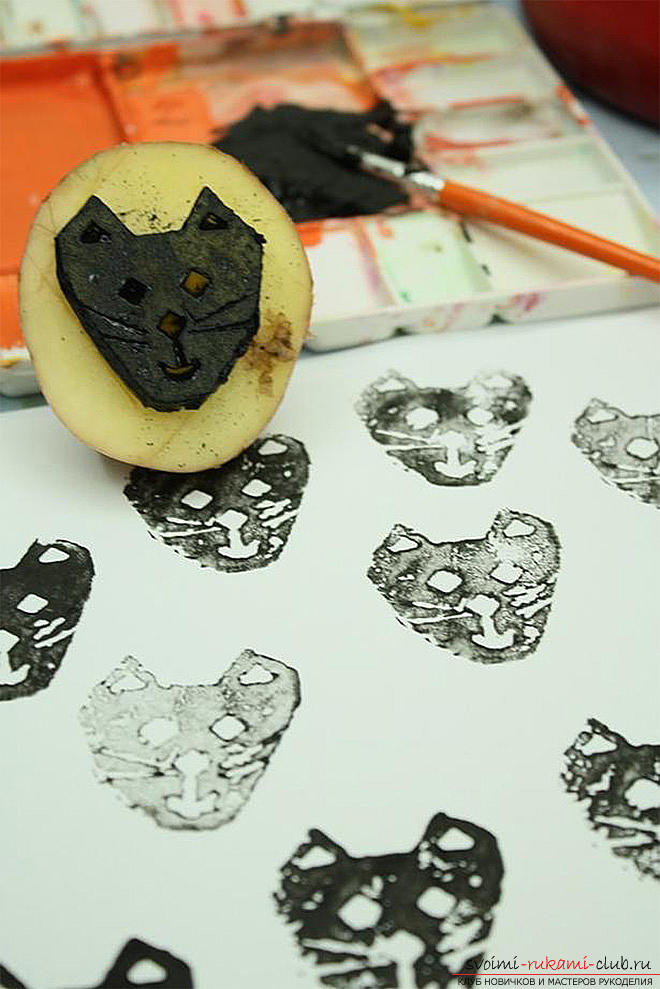 Tampon (imprint) crumpled paper,foam, foam. This will require a swab of any of the listed materials, a stamp pad as a palette and a paint. The tampon is pressed against the palette, and then the imprint is transferred to the paper. It turns out a beautiful fluffy, airy image. It is ideal to use when drawing fluffy animals, since such a technique transmits the texture of the wool. This method of drawing is akin to the previous one.
Tampon (imprint) crumpled paper,foam, foam. This will require a swab of any of the listed materials, a stamp pad as a palette and a paint. The tampon is pressed against the palette, and then the imprint is transferred to the paper. It turns out a beautiful fluffy, airy image. It is ideal to use when drawing fluffy animals, since such a technique transmits the texture of the wool. This method of drawing is akin to the previous one.  Poke with a rigid brush Here you need a hardbrush, thick gouache and thick paper. The dry brush is dipped in the paint, and then it is punched vertically on the paper. In the younger group the outline of the image is drawn by the educator. In average children themselves can draw a simple image. Pins should be started from the left side to the right so that there are no empty white spaces between them. The result is a beautiful animal or bird. Detailki dorisovyvayut detki thin part of the same brush.
Poke with a rigid brush Here you need a hardbrush, thick gouache and thick paper. The dry brush is dipped in the paint, and then it is punched vertically on the paper. In the younger group the outline of the image is drawn by the educator. In average children themselves can draw a simple image. Pins should be started from the left side to the right so that there are no empty white spaces between them. The result is a beautiful animal or bird. Detailki dorisovyvayut detki thin part of the same brush.  Using one or several techniques, a child can draw a wonderful drawing on his own and get a lot of pleasure from work.
Using one or several techniques, a child can draw a wonderful drawing on his own and get a lot of pleasure from work.


